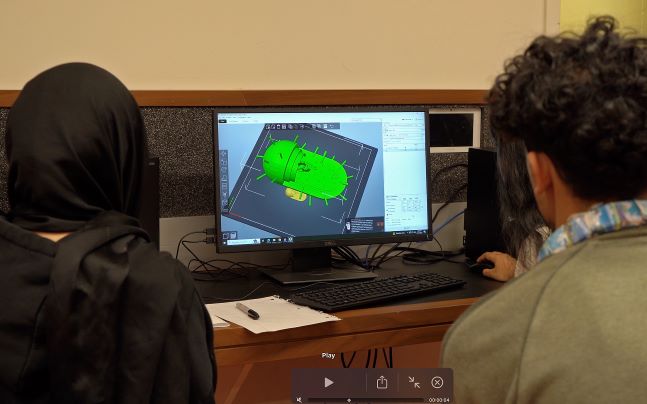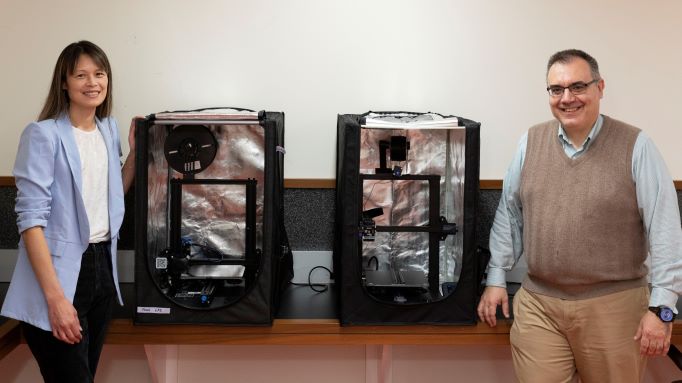
There’s a new instructional method taking place in introductory biology classes at SUNY Old Westbury: Listen, observe, discuss, research … and 3D print!
Three-dimensional versions of biological molecules, such as cells, organelles and other building blocks, have become the centerpiece of student activities and presentations through a new grant-funded initiative that seeks to increase passage rates of students in introductory biology courses and, ultimately, share the successful techniques with other institutions around the world.

“Building Bridges: Pedagogical Enhancement of the Introductory Biological Sciences Courses as a Pathway to Mentored Research” is the result of a two-year, $199,912 grant award from the National Science Foundation's STEM Education program.
“The basic idea of our grant activities is to really motivate students and get them excited very early on about learning basic core concepts that they will need for future courses,” said Kinning Poon, assistant professor of Biological Sciences and principal investigator on the grant. “We want to retain them in science courses and, for those in the major, start engaging them and preparing them as early as possible in aspects of research.”
Through the project, Old Westbury faculty members are developing interactive 3D-printed learning materials to enhance conceptual understanding, create open educational resources to reduce textbook costs, and implement a summer research experience program to expose students to mentored research. All project materials and findings will be openly licensed and shared to facilitate replication and adaptation at other institutions.
The anticipated outcomes include increased passing rates in introductory biology, greater participation of students – and especially Hispanic and underrepresented students - in STEM research and faculty engagement in evidence-based teaching approaches.
Early Response
The early returns were positive. The new methodology was introduced in three sections of Basic Biological Sciences I in fall 2024, enrolled by up to 34 students per section students.
At the close of the semester, student feedback highlighted the value of 3D models in enhancing learning through visualization, hands-on engagement, and deeper understanding. Students appreciated the ability to bring concepts to life and understand complex mechanisms, particularly in biology, through tangible and detailed representations. The models supported visual learners, helped clarify intricate details, and provided a clear way to grasp subjects.

In a continuation this spring, the effort has now moved into the Basic Biological Science II course where students will design and create their own 3D models on topics from the second semester of the introductory course and present them later in the term.
“It is important that they create their own structures,” said Christos Noutsous, assistant professor of Biological Sciences, who taught students in the fall cohort. “When you know that something belongs to you, you kind of love it more, and you kind of dedicate more time on it. So, by doing that, we hope that students will maximize and place even more effort into their work.”
Students will also upload their creative work in a repository linked as the sole authors and openly license their designs so that anyone in the world can use their work.
"In this way, students are not only using this 3D printing project for their own studies, but creating tools students in other regions and nations can use where the lower cost of 3D printing is more attainable than traditional models might be," said Poon.
Summer Research
In addition to the in-class enhancements, the grant will fund a summer research experience, Summer-BREaK, for up to 20 students who will work alongside faculty mentors in areas of study like neuroscience, bioinformatics, microbial ecology, neuro inflammation, and immunology. These opportunities will be held in collaboration with the campus’s Collegiate Science and Technology Entry Program and the campus’ Panther Center for Undergraduate Research and Engagement, which was created to focus on providing information, support and funding to undergraduates who seek both on and off campus research opportunities.
“Most of our Biology students want to go into some kind of medical field,” explains Poon. “Oftentimes it never occurs to them that research goes hand in hand with these fields. We want to get them engaged in those areas early on and not have them realize that they need this in their senior year and then scramble to try to find that experience when they are on the cusp of graduating.”
She notes that, after these summer placements, the goal will include having the students continue to conduct research alongside Old Westbury scientists or through external programs, which will strengthen their background and aid in future steps they might want to take, including medical school and other graduate school admissions.
Other activities related to this grant included the introduction of shorter course-embedded research experiences in the introductory labs. For the BS2401 lab, in collaboration with Cold Spring Harbor, students performed DNA barcoding using a nanopore. Students took samples from their shoes and used sequencing and bioinformatics data analysis to characterize the microorganisms that exist on their shoes from daily walking. This activity encompasses many of the topics that are taught in the introductory biology course and provided real world applications for what the students were learning.
Data from the first year of the grant-funded activities will be used by Poon and her colleagues to make an application to the NSF for additional funding to integrate what’s learned across the Biological Sciences curriculum.
“Ultimately, we hope we are able to make transformative change for our department and its students, while giving them even greater tools and understanding to achieve post-graduate success,” said Poon.
